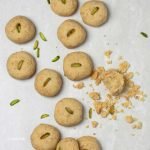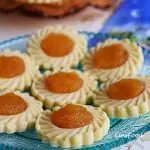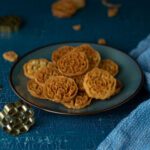Kuih Makmur are pretty little cookies filled with crushed toasted peanuts that is a must during Eid in Singapore and Malaysia (and Indonesia and Brunei). While not as iconic as Pineapple Tarts, they do still make an appearance at our other festivals too: Diwali, Christmas and Chinese New Year.
Estimated reading time: 11 minutes

What is Kuih Makmur?
So let’s take a look at the name first, shall we?
- coo – way, but the emphasis is on the second syllable. So it’s a fast coo.
- kuih = there is no direct translation for this Malay word, kue in Indonesian.
It refers to baked or fried goods like cookies, tea time treats and certain snacks.
But not cakes (which is kek). The plural is kuih-muih, referring to a variety. - Makmur = in Malay and Indonesian, this means successful, prosperous and anything along those lines.
No one really knows why they are called prosperous cookies; I wonder if it has something to do with the dusting of the icing sugar? Whatever the reason, they really are a delicious festive treat in all the countries mentioned above.

Where do Kuih Makmur come from?
We think they are a Middle Eastern legacy, the Malay version of ma’amoul, the date and nut filled semolina cookie from the Arab world.
If you’ve read the article on the Singaporean and Malaysian Recipes page, you’ll remember that I mention that there is a sizeable Arab population in these two countries. Since at one point in the 19th century, they owned more than half the island of Singapore, imagine the cultural wealth we’ve inherited. Makmur seems rather fitting then, doesn’t it?
The cookie, as you can see in the images here, have a delicate leaf pattern crimped on. Unlike ma’amoul, these are not as a result of using moulds. This leaf pattern is lovingly created with a pastry crimper on every single cookie, see images below. Like pineapple tarts, a true labour of love.
My Grandma’s Ancient Crimper!
My older sister has my granny’s really old stuff, like the manual, non electric egg beaters we used to make cakes with, pineapple tart moulds, and these crimpers.
Called sepit (which means pinch in Malay), it was what we used to create the patterns you see on these kuih makmur, as well as on our pineapple tarts before the patterned moulds were created.


Other names
There seems to be a lot of confusion on other food sites over Kuih Makmur and its allegedly different names, so I want to set the record straight. Many seem to think that kuih makmur, kuih momo and biskut Arab (Arab cookies) are the same thing.
They are not.
Kuih Momo are what Biskut Arab are called in Sarawak. And Kuih Mor in Brunei.
I think the reason behind this confusion is fairly obvious. Somewhere along the way, someone got lazy and couldn’t be bothered to fill and crimp kuih makmur. So they decided to mix the dough and the peanuts together, shaping them into balls, taking a cue from Biskut Kacang, the round peanut cookies.
And it obviously started a trend with the quick and easy brigade, a trend that as far as I’m concerned, should be outlawed.
I mean, imagine mixing the jam and the dough together and forming them into balls for Pineapple Tarts. Aiyoh, the horror!
Kuih Makmur are not Kuih Momo
And perhaps because both the lazy kuih makmur and biskut Arab are covered in icing sugar, the two got mixed up. And unless you have a family history of making festive cookies (instead of buying them), then you are not going to know any better.
Kuih Momo and Biskut Arab Susu are also festive cookies that are shaped into balls. But there is nary a peanut in sight; the cookies are made with flour, milk powder, sugar and butter or ghee. They are then shaped into balls and dusted with icing sugar.
The only similarities are the shape of the lazy makmur and the icing sugar dusting.
So kuih makmur are not kuih momo, and they are not biskut Arab. And while I’m at it, they shouldn’t be formed into balls!
Come on, we make them once a year, maybe twice. Not that big a hardship, really, is it?

My Kuih Makmur Recipe
All my Singaporean and Malaysian Eid festive recipes are my granny’s, and this kuih makmur is no different. I’ve received so many requests over the years for it, and am finally getting around to it because of this new site dedicated to all things Singaporean and Malaysian.
But you know something? The last time I made them, I was still living in Singapore, that means early 1990s! But I guess some things you never quite forget.
A couple of my readers from LinsFood queried the use of ghee in Kuih Makmur recently. So when I went online, imagine my surprise when I saw that practically everyone was using ghee to make kuih makmur, most of which were the lazy kind.
In fact, some food sites even referred to them as ghee cookies, which is just weird, but never mind, I think I’ve ranted enough for one post.
So I sent my sisters a message, because I sure don’t remember us ever using ghee when making these peanut filled cookies. Here’s what I found out.
How my Sisters make Kuih Makmur
- My older sister uses butter, while my younger sister has switched to ghee, preferring the flavour. Note: switched, so it wasn’t always so. Like nasi minyak, the transition to ghee, is a fairly modern thing (I’m talking last 20 – 40 years or so).
- Both add sugar to the cookie dough. The older uses caster sugar, while the younger uses icing sugar (powdered sugar in US). I remember that we always added a little sugar to the dough as kids, but what I couldn’t remember was whether it was caster or icing.
So, I made 2 batches, 1 with ghee and icing sugar, the other with butter and caster sugar.

Initial Conclusion
I’m not totally convinced on the conclusion, I’ll have to test them a whole lot more and update here when I’m sure!
It’s Ramadan right now, and here in the UK, we break fast after 8pm. By the end of the fasting month, it’ll be 8.45pm. So there isn’t a whole lot of time (nor space in one’s tummy) to eat. But here’s what my kids and I think so far.
- I prefer the butter version, while my kids prefer the ghee ones. Kuih makmur made with ghee have a richer, creamier and slightly softer feel to them. They also lean towards a more yellow colour.
I thought the ones made with ghee were too rich, along with the sugared peanut filling. But they certainly had a better aroma than the butter ones. If you like ghee, that is. But who doesn’t? - Icing sugar in the dough produces a smoother texture and also contributes to the softness.
If you guys use this recipe, let me know what you think. I’ll add both butter and ghee to the recipe, but will definitely suggest going down the icing sugar route.
Also, if you use this recipe, take pictures and post them on social media and tag me. Or email me the pics.
Making Kuih Makmur at Home
I won’t lie, it takes a while. But just like kuih tart, it is sooo worth it! I ran a live class last week on Zoom, teaching these cookies (and pineapple tarts the week before). Sometimes, you just get a class with lots of questions, and problems, and that was one of them.
In the recipe below, I suggest that you form little balls from the dough, before going on to shape, fill and crimp. That way, your cookies will look fairly uniform in size. But in the class I ran, most of them just kept moaning that they didn’t know what size to make the balls! Honestly.
So I got my weighing scales out and weighed a ball! As long as your kuih makmur balls are about 17-20g a piece, we’re good.
Kuih Makmur Step by Step Pictures








How long will Kuih Makmur Keep?
Like most Eid cookies, they will last a good 2 weeks, even 3. After 3 weeks, I have always found that homemade kuih raya are not as fresh anymore, and I’d rather not eat them.
Store them in an airtight container, somewhere cool, if possible. I know if you are in the tropics, that’s not really possible, store them away from direct sunlight.
And now, shall we get baking?
♥ If you like the recipe and article, don’t forget to leave me a comment and that all important, 5-star rating! Thank you! ♥
And if you make the recipe, share it on any platform and tag me @azlinbloor, and hashtag it #linsfood
Lin xx
Images by LinsFoodies



More Eid Kuih
Head on over to the Eid page for more ideas. This site is jut over a year old, so more recipes will come in as time goes by.




Traditional Kuih Makmur (Malay Peanut Filled Eid Cookies)
Equipment
- large bowls
- weighing scales
- spoons
- baking trays x 4
- pastry crimper
- small mesh sieve for dusting icing sugar
- airtight container for storing
Ingredients
For the Sweet Shortcrust Pastry (Kuih Makmur Dough)
- 500 g AP flour
- 90 g icing sugar (powdered sugar in the US)
- 250 – 300 g salted butter, at room temperature (or ghee – if using ghee, add a pinch of salt to the dough)
- 1-2 Tbsp cold water ONLY if needed
The Peanut Filling
- 100 g raw or blanched skinned peanuts
- 75 g caster sugar (white)
For Crimping
- small bowl of flour
Instructions
Let's toast the Peanuts
- Place the raw or blanched peanuts in a large frying pan over medium heat and toast for 10 minutes. Be sure that the pan is large enough for the nuts to be in a single layer.

- Turn the heat down to medium-low after 2 minutes, so the peanuts don't brown too quickly and burn.

- Keep tossing and flipping the peanuts until they are a light brown colour and giving off a sweet and nutty aroma.
- When done, tip the nuts onto a large, flat plate and leave to cool for 20 minutes.Then, place them in a chopper and pulse to a fine state, but be careful not to overdo it to the oily stage. Do these in batches if your chopper isn't big enough. When the peanuts resemble small grains of wet sand, you're done.

- Tip the ground peanuts into a medium bowl and add the caster sugar. Mix thoroughly until needed.

Let's make the Kuih Makmur Dough
- Let's do this while the peanuts are cooling down. Sift the flour and icing sugar into a large bowl. Set aside. (Ignore the small bowl in the image, I was making a smaller amount).

- Using a wooden spoon, cream the butter slightly in another bowl, until soft and a little light in colour. Basically, you are just going to be stirring that butter for about a minute.If using ghee, make sure it's runny, but you don't have to heat it, unless it's winter time, and it's hard.

- Add about ¾ of the butter to the flour. Now, using your fingertips, gently rub the flour and butter to get a coarse mix that resembles wet sand, adding butter as needed.

- Add a little more butter and rub this in, again with your fingertips. Keep adding the butter, until you get a dough that comes away from the bowl and doesn't crumble.To test if it's ready, take a pinch of dough, make a ball, and press down flat on your palm. If it cracks quite a bit (instead of just at the edges like in the picture), it's too dry. So add a little more butter.Remember, we are going to be filling our flat pastry with nuts, then sealing. So if your dough is crumbly now, you'll have trouble later.

- If you've used up all your butter (or ghee), and your pastry is still too dry, then add a tablespoon of the cold water and that should be enough to bring your dough together.
Filling Kuih Makmur
- Divide your dough into two. Cover the one with a clean tea towel while you work on the other. Form little balls out of your dough, slightly smaller than pingpong balls. As mentioned above, each should weigh between 17-20g. Place on a large plate.

- Get a baking tray and the peanut filling ready. Get 1 ball and flatten with the base of your palm. Then, using your thumb, press down in the middle of the disc, to make a slight bowl shape. You probably have to press down with your thumb twice in two different directions.

- Using a tsp, fill the bowl shaped dough with the nut filling. I used about ¾ tsp for each cookie. Don't overfill, as you'll have trouble closing it.

- Bring the ends of the dough together, pinching lightly to seal. You'll end up with a crescent shaped cookie with a slightly flat bottom. Like Chinese dumplings or curry puff. Place your filled kuih makmur on the baking tray. Repeat with all the balls. Then move on to the second half of the dough.As each tray is filled up, cover with a tea towel to prevent from drying out. Or, you could heat the oven up after filling 2 trays, before crimping the first one.

Crimping Kuih Makmur
- Get your bowl of flour ready. Preheat the oven to 160°C/320°F (140° Fan).

- Dip your crimper in the flour and shake of excess. Now, crimp the top of the cookie from end to end.

- Then, do one side, starting from the top, going down, and at an angle. You are essentially crimping out the veins of a leaf. Do the same on the other side, making sure that the pattern is flowing in the same direction.Repeat with all the filled cookies.

- When you are done with one tray, place the tray in the oven and bake for 15 – 18 minutes. If your oven runs cool, you may even need to go to 20 minutes. The cookies are done when they are a pale golden colour.You could also bake two trays at a time, which is what I do. The top tray may be done a couple of minutes before the bottom one.

- Take the tray out of the oven and leave to cool for 5 minutes before dusting with icing sugar.

- Finish crimping and baking the rest of the cookies.
- Let the cookies cool down completely before storing in an airtight container.

37 thoughts on “Traditional Kuih Makmur (Malay Peanut Filled Eid Cookies)”